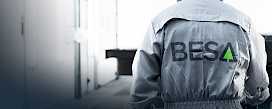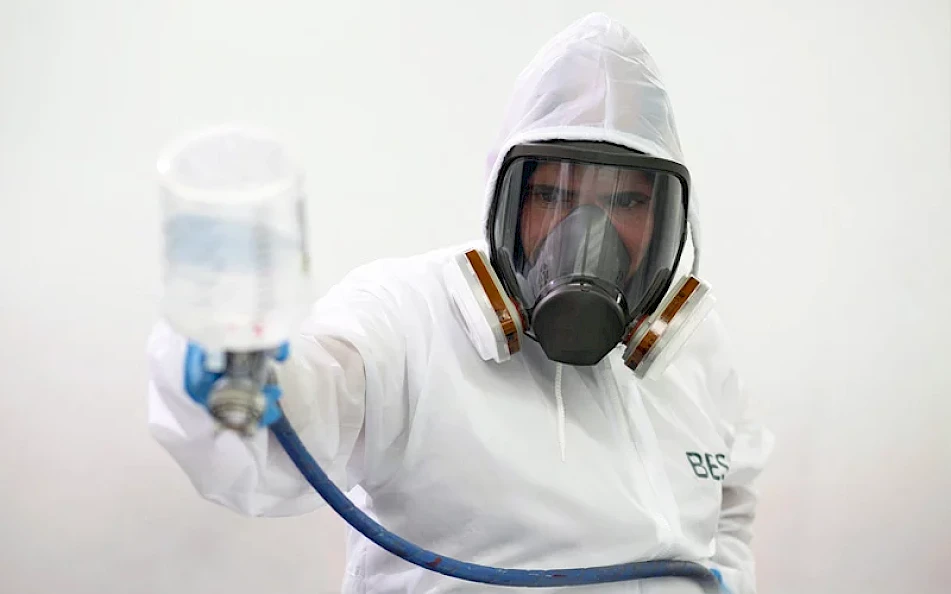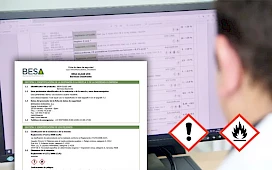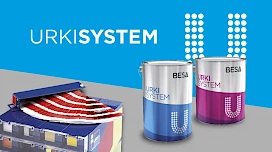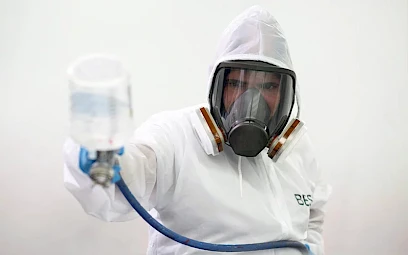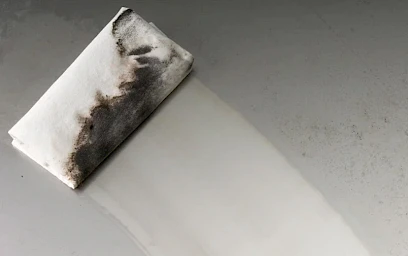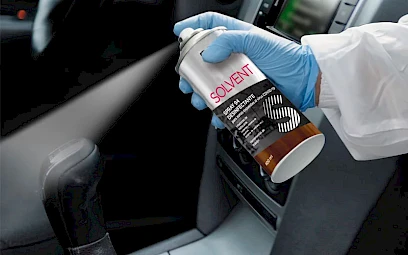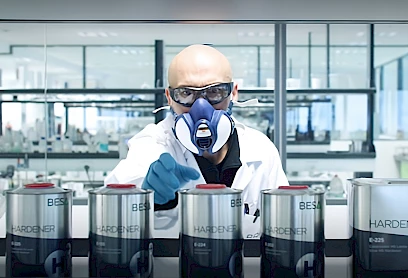Classification of Personal Protective Equipment
Knowing the different types of equipment, their usefulness and their correct use will allow workers to be sure that the product handling process is carried out without any risk.
PPE must be used when there are risks that could not be prevented or limited by technical means or collective protection, or by methods or procedures involving work organisation.
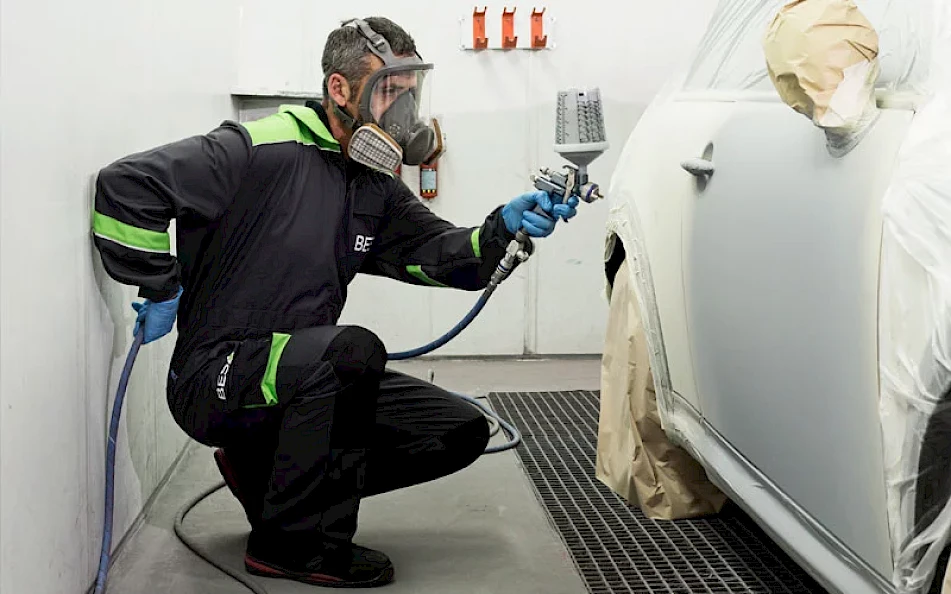
PPE (Royal Decree 733/95) for handling chemicals are classified according to their category:
Category 1 PPE
Simple design. Protects against minor or light risks. This type of PPE is self-certified by distributors or manufacturers (e.g. non-technical workwear, coveralls, gloves for minimum risks, etc.).
Category 2 PPE
Designed for intermediate risks. Protects against usual risks in the industry: Certified by an accredited laboratory or control body (e.g. anti-cutting footwear, safety glasses, hearing protectors, etc.)
Category 3 PPE
Complex design. Protects against irreversible, life-threatening or very serious risks or injuries. Certified by a laboratory or notified body, in addition to a manufacturing control by the same body (helmets, anti-fall systems, chemical risk gloves, etc.).
All Personal Protective Equipment is subject to approval and must bear the EC (European Conformity) mark.
Types of PPE according to their protective function
Respiratory protection equipment
► Masks

Some masks have filters in the form of cartridges that can be replaced when their efficiency decreases. These cartridges, which must always comply with EN 141 and 143 standards, contain activated carbon that purifies the air inhaled when breathing in solvent vapours.
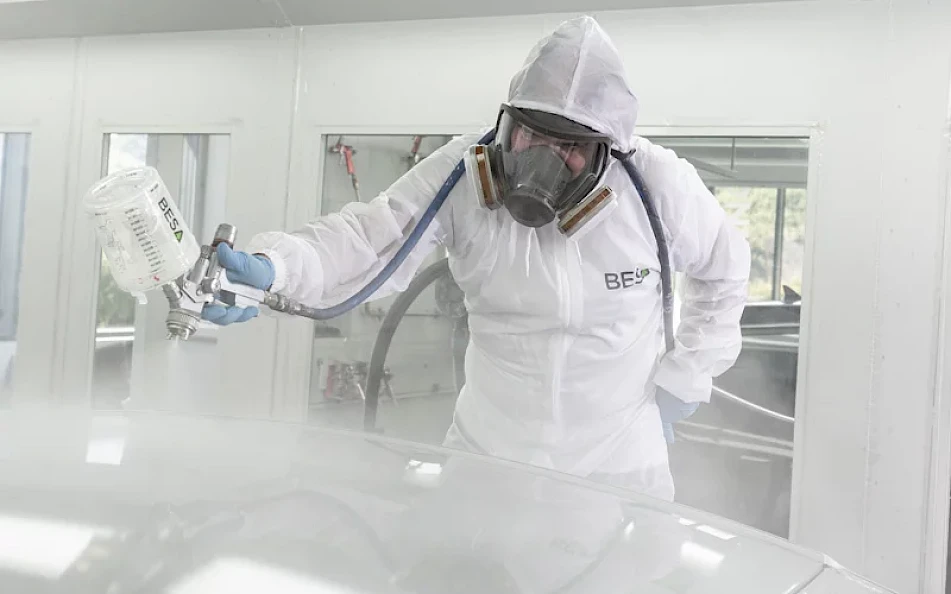
Using these masks is recommended when using solvents to clean painters’ tools, guns and when applying certain paint products.
Replacement of filters
Establishing a filter’s time of effectiveness is impossible, since several factors influence its duration; relative humidity, temperature, respiratory rate, lung capacity, concentration and nature of the contaminant. It is advisable to replace the filter when an increase in respiratory resistance or the smell of the contaminant is noticed.
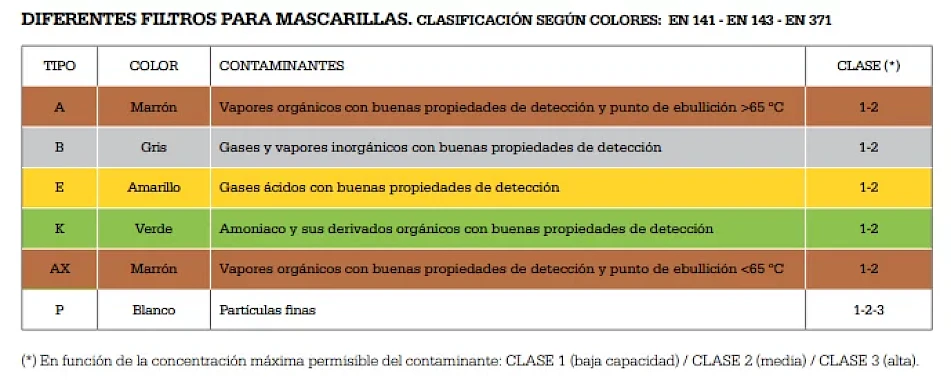
The different types of masks must comply with European Standards, and are classified according to Directive 26/656/EEC:
- EN-136: Face masks (1). Requirements. Market testing.
- EN-140: Half-masks are defined as a facial piece that covers nose, mouth and chin, and a quarter-mask as a facial piece that covers nose and mouth (2).
- EN-141: Classifies gas filters (3) (removes specific gases and vapours) and mixed filters (removes dispersed solids and/or liquid particles and gases and vapours).
- EN-143: Classifies particle filters (4) into solid (P-1), solid (P-2) or solid and liquid (P-3).
- EN-149: Self-filtering masks against particles (5). It prevents particles and/or water-based aerosols from entering your nose and throat along with the air that you inhale. They are usually made of paper, cardboard or certain types of colloids. They must retain particles no larger than 5 microns and are usually engraved with the type of mask (FFP1; FFP2, FFP3). They are highly recommended for putty sanding work and any type of dry paint. Not suitable for solvent vapours.
- EN-405: Self-filtering masks with a gas and vapour valve. Minimum requirements for masks consisting of a face piece with a gas/vapour filter, which are an integral part of the mask) (6).
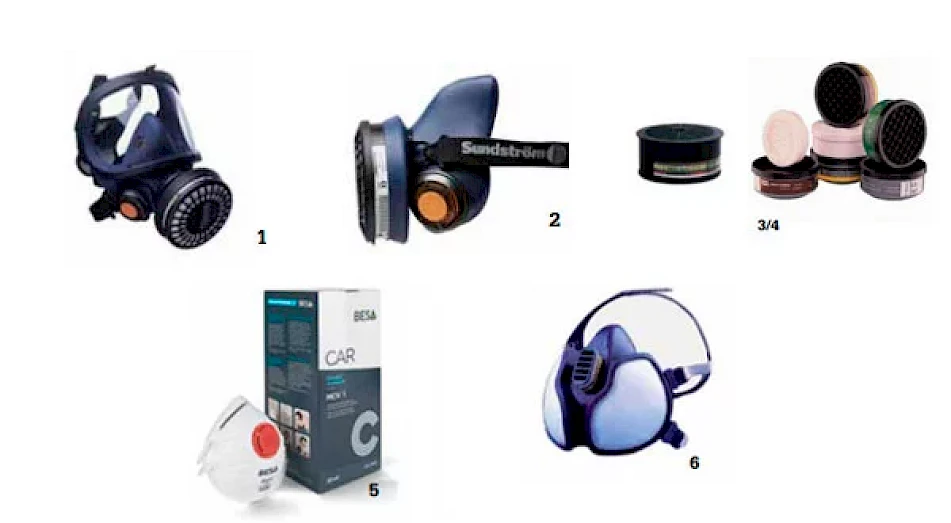
► Self-contained breathing apparatus
- EN-1146: Self-contained open-circuit respiratory equipment (7). Motorised equipment that filters the air and pumps it into the approved mask or cap, creating an overpressure of clean air inside it, increasing the level of protection. Appropriate filters should be used for each working environment: for gases, particles or combined.
- EN-401: Self-contained closed-circuit respiratory equipment (8). This equipment ensures a supply of clean air from a cylinder to the inside of the approved mask. Positive pressure is maintained inside the mask, preventing the penetration of contaminants and increasing the level of protection.
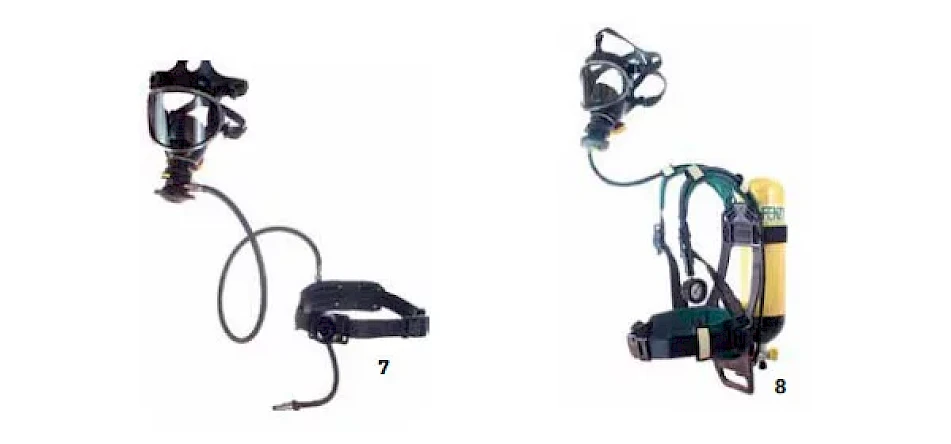
► Self-contained painting equipment
Comprehensive airway protection set consisting of an activated carbon filter, an air supply tube and a face shield. The air contained between the painter’s face and the screen is at a higher pressure than that existing outside, thus preventing contaminated air from entering the mask and being breathed by the painter.
To choose one or another mask and/or filter, you must know the contaminant, its concentration and toxicity, the TLV* value, the nominal protection factor* of the protector, and the required protection factor.
*TLV or Threshold Limit Value It is the maximum concentration of a substance contained in the air, calculated as an average over a 40-hour period per week during which, according to current knowledge, that a worker can be exposed to every day without probable health risk.
*Nominal protection factor: the ratio between the concentration of a contaminant in the environment and its possible concentration inside the mask. It is calculated based on a standard EN test.
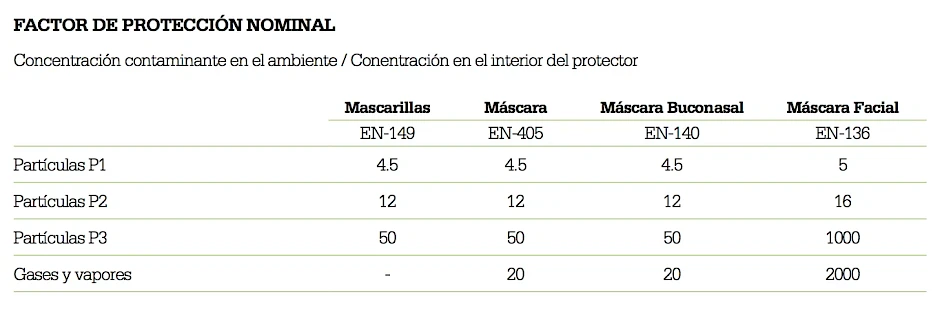
Safety footwear
When working with paints and solvents, you should choose safety shoes that, among other features, are antistatic and resistant to chemical agents.

► Antistatic safety footwear
In some workplaces, such as those where flammable materials are present, or where the concentration of static electricity must be minimised, workers should be required to wear antistatic footwear.
This type of footwear contains conductive soles, which are designed to reduce the accumulation of static electricity, despite maintaining a level of electrical resistance in the range 105 – 109 ohms (electrical resistance units).
Please note that they must not be used in the vicinity of open electrical circuits or electrically charged equipment.
► Safety footwear in chemical laboratories
Safety footwear should always be used in areas where chemicals are used or stored. Perforated shoes, sandals or similar should not be worn in these areas. Appropriate footwear should cover and protect the entire foot. Materials, including the sole, must be compatible with the local environment, the materials handled and the tasks performed.
Depending on the types of risks that may be present in the area, safety footwear should provide additional protection. Safety footwear with soles that are resistant to slipping, abrasion, hydrocarbons and oils or heat should be considered. When the main damage is due to impacts, punctures, electric current or static electricity, appropriate footwear should also be worn.
Protection gloves for handling chemicals

Solvents and thinners remove the oil from the skin, dry it out, crack it and make it particularly sensitive to pathogens, leading to skin diseases that in most cases appear over the years.
This is why, gloves that have been approved for this purpose should be used.
Protection gloves against chemicals and micro-organisms are subjected to different tests to prove their effectiveness.
A timetable should be set to regularly replace the gloves in order to ensure that they are renewed before they are permeated by chemicals. The use of contaminated gloves can be extremely dangerous because of the accumulation of contaminants in the glove component material.
Gloves should always be cleaned according to the manufacturer’s instructions.
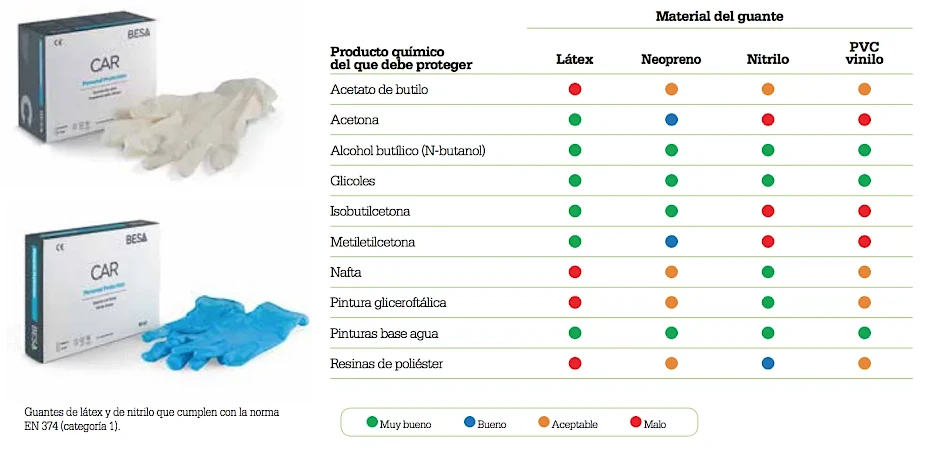
Protection eyewear
Obviously, the main purpose of wearing protection eyewear is to protect workers’ eyes.

When is it advisable to use this?
Especially when handling solvents and also when compressed air is used to blow powders and dried solvents in degreasing operations.
In certain cases, when they are to be used continuously by someone who needs prescription glasses, using prescription safety glasses should be considered.
In addition, using contact lenses in painting and degreasing processes should be carefully considered since:
- It will be virtually impossible to remove the contact lenses from the eyes after a chemical agent is spilled in the eye area.
- Contact lenses will interfere with emergency washing procedures.
- Contact lenses can attract and trap fumes and solid materials in your eyes.
- If chemicals enter the worker’s eye and then becomes unconscious, emergency staff will not notice that they are wearing contact lenses.
Hooded coveralls or overalls
Overalls should be used when painting with spray guns, as they prevent the fog produced from coming into contact with any part of the body.
To prevent problems related to static loads, staff working in facilities where flammable liquids are transferred shall not wear synthetic fibre clothing. Preferably choose clothes that are made of cotton, including underwear. It is also advisable to limit the use of wool garments to the extent possible.
Emergency showers and eye baths
Emergency showers and eye baths provide immediate decontamination by water projection protecting by dissolution and extractive washing of aggressions by chemical products, that could cause serious and irreparable injuries.
This is the best and most practical decontamination method discovered to date.
The shower should provide a sufficient flow of water to soak the subject completely and immediately. The water supplied should be drinkable, not cold (preferably between 20 and 35°C) to prevent the risk involved in cooling a burned person who is in a state of shock, and also the fact that cold water may lead to a shorter timer showering thus leading to insufficient removal of contaminant.
It is also convenient to have drainage (making maintenance much easier). The most suitable models are those with a triangular actuator attached to the system through a fixed bar (better than with a chain). Clothing, shoes and jewellery should be removed while under the shower.
How to use the eye bath station?
- Contact lenses should be removed as soon as possible to wash the eyes out and completely remove hazardous chemicals.
- The water should not be applied directly to the eyeball, but to the base of the nose. This makes eye washing more effective by extracting the chemicals (powerful water jets can reintroduce particles into the eyes).
- The eyelids should be forced open to ensure washing inside.
- Be sure to wash from the nose to the ears; this will prevent chemicals from entering the unaffected eye.
- Eyes and eyelids should be washed for at least 15 minutes.
- After washing, both eyes should be covered with a clean or sterile gauze.






